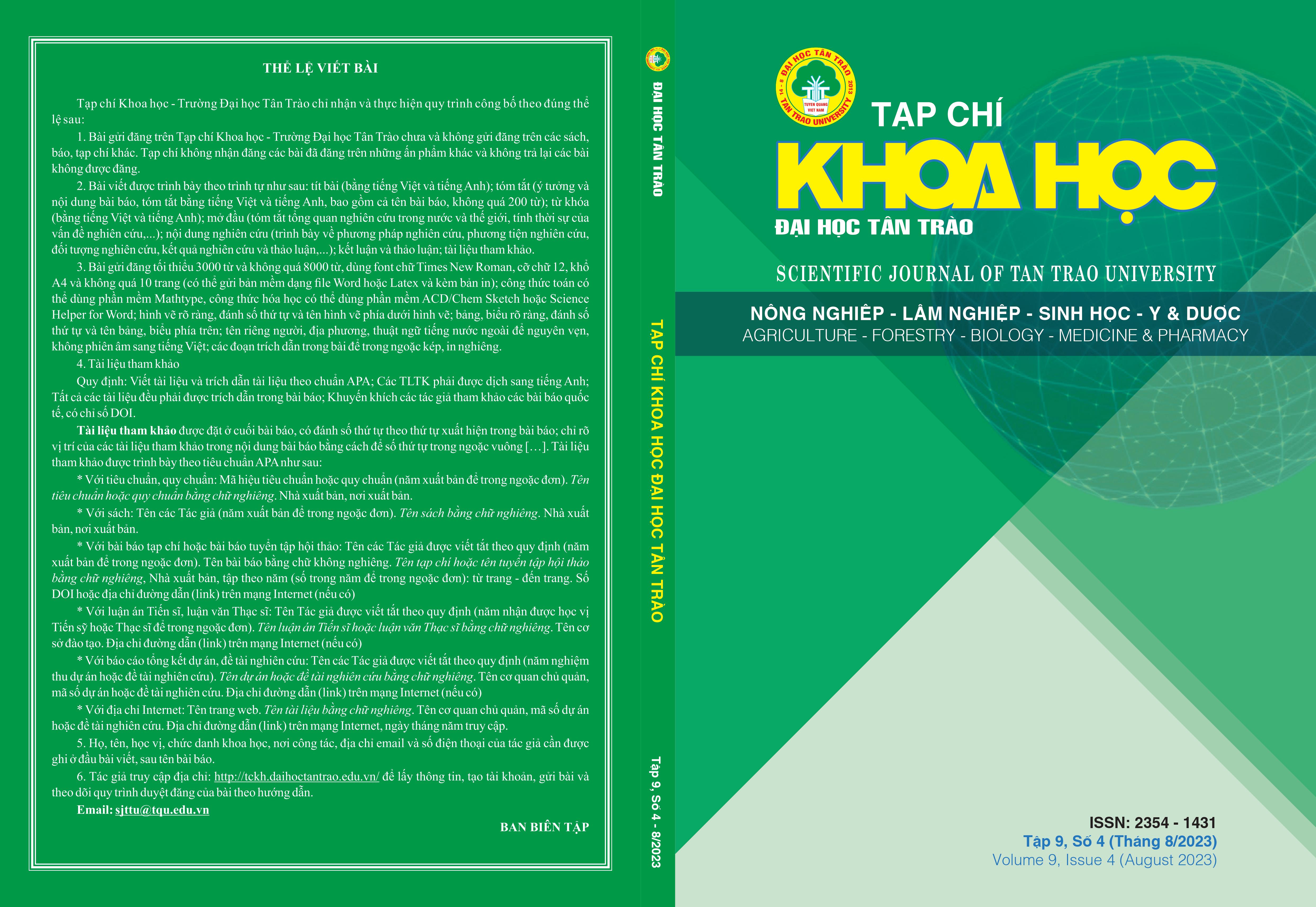NGHIÊN CỨU THÀNH PHẦN HÓA HỌC CAO CHIẾT N-HEXANE CỦA CÂY SÓI RỪNG (SARCANDRA GLABRA) Ở THÁI NGUYÊN
DOI:
https://doi.org/10.51453/2354-1431/2023/1011Từ khóa:
Alocasia macrorrhiza; n-hexane; Thái NguyênTóm tắt
Bằng các phương pháp sắc ký cột, sắc ký lớp mỏng, từ cặn chiết n-hexan, etyl axetat của cây Sói rừng (Sacandra glabra) đã phân lập được 03 hợp chất sạch. Sử dụng các phương pháp phổ cộng hưởng từ hạt nhân (NMR) đã xác định được cấu trúc hóa học của 3 hợp chất: trong đó 01 hợp chất Stigmast-5,22-dien-3-β-ol (1) và 2′,6′-dihydroxy-3′,4′-dimetoxychalcon (2) và 5-hydroxy-6,7-dimetoxyflavanon (3).
Tải xuống
Tài liệu tham khảo
[1] Nor'Aishah Hasan, Suhaidi Ariffin, Azzreena Mohamad Azzeme, Nur Intan Hasbullah, Mohd Zaini Nawahwi, Izzaz Hafiezy Bin Zemry. Preliminary phytochemical screening of medicinal herb, SAMBAU PAYA (Chloranthus erectus), Materials Today: Proceedings. 2023. 1-4.
[2] Chi, V.V. (1997). Vietnamese medicinal plant dictionary Medicine. Publishing House - Ho Chi Minh.
[3] Ho, P.H. (1999). Plants and Grasses of Vietnam. Youth Publishing House - Ha Noi.
[4] Yuan-yuan Liu, Yu-ze Li, Shi-qi Huang, Hua-wei Zhang, Chong Deng, Xiao-mei Song, Dong-dong Zhang, Wei Wang. (2022). Genus Chloranthus: A comprehensive review of its phytochemistry, pharmacology, and uses. Arabian Journal of Chemistry. 15. 1-40.
[5] Kui-Wu Wanga, Man-Qing Zhoua, Qin Gua, Nazia Bibi Auckloob, Xiao-Dan Wuc, Bin Wu. (2016). Unusual new phenylethanoid and phenylpropanoid diglycosides from
the leaves of Chloranthus spicatus (Thunb.) Makino. Phytochemistry Letters. 17. 201-205.
[6] Sang-Yong Kim, Yoshiki Kashiwada, Kazuyoshi Kawazoe, Kotaro Murakami, Han-Dong Sun, Shun-Lin Li, Yoshihisa Takaishi. (2009). Spicachlorantins A and B, new dimeric sesquiterpenes from the roots of Chloranthus spicatus, Phytochemistry Letters. 2(3). 110-113.
[7] Yuanlian Zeng, Junyu Liu, Qiang Zhang, Xuhua Qin, Zulun Li, Guojuan Sun, Shenrui Jin. (2021). The Traditional Uses, Phytochemistry and Pharmacology of Sarcandra glabra (Thunb.) Nakai, a Chinese Herb With Potential for Development: Review. Frontiers in Pharmacology. 12. 1-24.
[8] Hailemichael Tesso, Wilfried A. König, Son, P.T., Giang, P.M. (2006). Composition of the essential oil of flowers of Chloranthus spicatus (Thunb.) Makino. Flavour of Fragrance Journal. 21(4). 592-597.
[9] Thang, T.D., Dai, D.N., and Isiaka A. Ogunwande. (2016) Composition of essential oils from chloranthus elatior and ch. spicatus from vietnam. 52(1). 149-151.
[10] Yong-Jiang Xua.(2013) Phytochemical and Biological Studies of Chloranthus Medicinal Plants. 10. 1754-1773.
[11] Fei Teng, Hui-Min Zhong, Chang-Xiang Chen, Hai-Yang Liu. (2009). Helvetica. 92(7). 1298-1303.
[12] Qiu-Hong Wang, Hai-Xue Kuang, Bing-You Yang, Yong-Gang Xia, Jun-Song Wang, and Ling-Yi Kong. (2011). Sesquiterpenes from Chloranthus japonicus. J. Nat. Prod. 74(1). 16-20.
[13] Yoshio Takeda, Hiroyasu Yamashita, Takashi Matsumoto, Hiromitsu Terao. (1993). Chloranthalactone, A sesquiterpenoid from the leaves of Chloranthus glaber. Phytochemistry. 33(3). 713-715.
[14] Bin Wu, Shan He, Yuanjiang Pan. (2007). Sesquiterpenoid with new skeleton from Chloranthus henryi. Tetrahedron Letters. 48(3). 453-356.
[15] Peng Wang, Rui-Jun Li, Rui-Huan Liu, Kai-Li Jian, Ming-Hua Yang, Lei Yan, Ling-Yi Kong, and Jun Luo. (2016). Sarglaperoxides A and B, Sesquiterpene-Normonoterpene Conjugates with a Peroxide Bridge from the Seeds of Sarcandra glabra. Org. Lett. 18(4). 832-835.
[16] Jun Kawabata, Satoshi Tahara, Junya Mizutani. (1981). Isolation and Structural Elucidation of Four Sesquiterpenes from Chloranthus japonicus (Chloranthaceae). Agricultural and Biological Chemistry. 45(6). 1447-1453.
[17] Xiu-Feng He, Sheng Yin, Yin-Chun Ji, Zu-Shang Su, Mei-Yu Geng, and Jian-Min Yue. (2010). Sesquiterpenes and Dimeric Sesquiterpenoids from Sarcandra glabra. J. Nat. Prod. 73(1). 45-50.
[18] Gang Ni, Hua Zhang, Hong-Chun Liu, Sheng-Ping Yang, Mei-Yu Geng, Jian-Min Yue. (2013). Cytotoxic sesquiterpenoids from Sarcandra glabra. Tetrahedron. 69(2). 564-569.
[19] Okamura Hiroaki, Nakashima Nobutoshi, Iwagawa Tetsuo, Nakayama Noboru, Nakatani Munehiro. (1994). The Structures of Two Lindenane Sesquiterpene Glucosides from Chloranthus glaber. Chemistry Letter. 23(8). 1541-1542.
[20] Oanh, D.T., Ky, P.T., Hang, N.T.B., Yen, P.H., Hanh, T.H., Cuong, N.X., Luong, D.V., Minh, C.V. & Kiem, P.V. (2010). Two New Sesquiterpenes from Sarcandra glabra. Natural Product Communications. 5(11). 1717-1720.
[21] A. V. Kurkina, T. K. Ryazanova & V. A. Kurkin. (2013). Flavonoids from the Aerial Part of Polygonum hydropiper. Chemistry of Natural Compounds. 49. 830-832.
[22] Thuy, T.T.T., Quan, T.D., Anh, N.T.H., Sung, T.V. (2009). Chemical constituents of Miliusa sinensis Finet et Gagnep. (Annonaceae). Journal of chemistry. 47(6). 745-748.
Tải xuống
Đã Xuất bản
Cách trích dẫn
Số
Chuyên mục
Giấy phép

Tác phẩm này được cấp phép theo Giấy phép Quốc tế Creative Commons Attribution-ShareAlike 4.0 .
Bài báo được xuất bản ở Tạp chí Khoa học Đại học Tân Trào được cấp phép theo giấy phép Ghi công - Chia sẻ tương tự 4.0 Quốc tế (CC BY-SA). Theo đó, các tác giả khác có thể sao chép, chuyển đổi hay phân phối lại các bài báo này với mục đích hợp pháp trên mọi phương tiện, với điều kiện họ trích dẫn tác giả, Tạp chí Khoa học Đại học Tân Trào và đường link đến bản quyền; nêu rõ các thay đổi đã thực hiện và các nghiên cứu đăng lại được tiến hành theo cùng một bản quyền.
Bản quyền bài báo thuộc về các tác giả, không hạn chế số lượng. Tạp chí Khoa học Tân Trào được cấp giấy phép không độc quyền để xuất bản bài báo với tư cách nhà xuất bản nguồn, kèm theo quyền thương mại để in các bài báo cung cấp cho các thư viện và cá nhân.
Mặc dù các điều khoản của giấy phép CC BY-SA không dành cho các tác giả (với tư cách là người giữ bản quyền của bài báo, họ không bị hạn chế về quyền hạn), khi gửi bài tới Tạp chí Khoa học Đại học Tân Trào, tác giả cần đáp ứng quyền của độc giả, và cần cấp quyền cho bên thứ 3 sử dụng bài báo của họ trong phạm vi của giấy phép.






